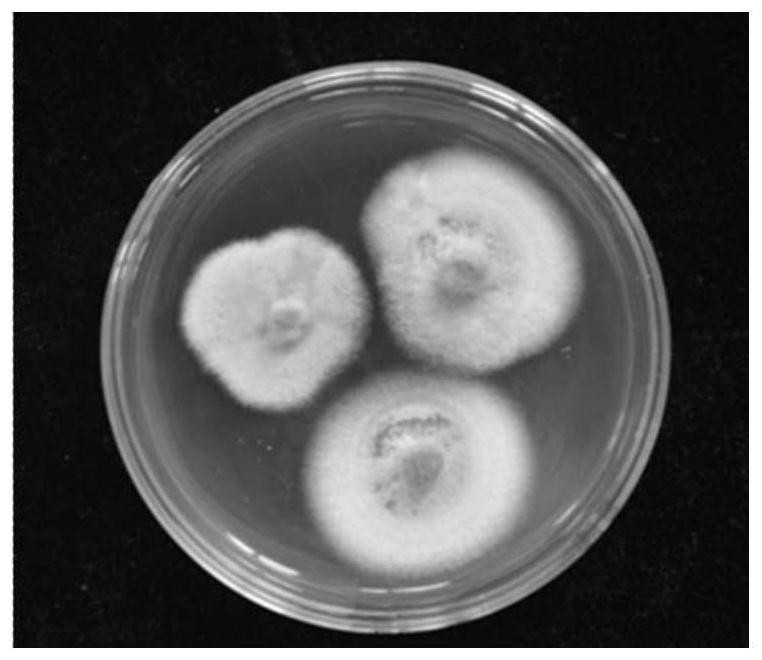Microchromodispora fungus hnu107 and its application in the degradation of ammonia waste gas
A technology of HNU107 and Chromodispora, which is applied in the field of environmental pollution control, can solve the problems of difficult preservation, rapid degradation, and low efficiency, and achieve the effects of shortening domestication time, good storability, and improved removal efficiency
- Summary
- Abstract
- Description
- Claims
- Application Information
AI Technical Summary
Problems solved by technology
Method used
Image
Examples
Embodiment 1
[0034] Example 1: Isolation and cultivation of the microchromodispora fungus "HNU107"
[0035] The microchromodispora fungus "HNU107" is isolated from the bioreactor of Rousselot (Wenzhou) Gelatin Co., Ltd. The design structure of the biotrickling filter reactor is as follows: figure 1 shown.
[0036] The separation method is as follows: Take 5 g of domesticated bioreactor sludge, dilute it with distilled water to three different concentration gradients of 10 times, 100 times and 1000 times, and spread it on the PDA fungal solid medium respectively. Each petri dish was coated with one milliliter of the diluted sludge solution, cultured at a constant temperature and dark at 25 degrees, and observed the independent colonies formed after culturing for one week. Pick the mycelium from the edge of the selected colony, transfer to a fresh PDA plate for streak separation and culture, repeat until a pure culture is obtained, and transfer to a PDA slant for storage.
Embodiment 2
[0037] Example 2: Morphological and molecular biological identification of the fungus of the genus Leuchromodispora "HNU107"
[0038] Under a microscope, observe the characteristics of endophytic fungi such as colonies, hyphae, and spores, and identify them by referring to the "Handbook of Fungal Identification". Specifically, the screened strains were inoculated on a PDA plate by spot seeding method, cultured at a constant temperature of 28 degrees, and the morphological characteristics of the strains were observed with the naked eye, including colony shape, color, size, edge characteristics, mycelial properties, and growth speed. and other features. The hyphae on the surface of the colony were picked and placed on an optical microscope (Japan, OLYMPUS) to observe the presence or absence of spores and sporulation structures.
[0039] The morphological characteristics of the microchromodispora fungus "HNU107" of the present invention are as follows:
[0040] like figure 2 an...
Embodiment 3
[0041] Example 3: Molecular Biological Identification of Microchromodispora Fungus "HNU107"
[0042] Genomic DNA of Leuchromodispora fungus "HNU107" was extracted by general fungal DNA extraction method. The extraction method is as follows: take 1.5mL bacterial liquid, 12000×g, 2min, collect the bacterial cells; add 500μL 5×CTAB (containing 1% β-mercaptoethanol), quick-freeze in liquid nitrogen for 30s, then transfer to 65°C for 30s, Repeat the above process 3 times; vortex at high speed for 3-5min, incubate at 65°C for 20min, add 2mL of phenol:chloroform:isoamyl alcohol (25:24:1, V / V / V), 12000×g, 10min, take Supernatant: Add 2 times the volume of absolute ethanol to the supernatant, centrifuge again after standing still for 20 minutes; pour off the supernatant, wash the precipitate with 70% alcohol; dry under natural conditions to obtain fungal DNA for later use.
[0043] Using fungal universal primers ITS5 (5'-GGAAGTAAAAGTCGTAACAAGG-3') and ITS4 (5'-TCCTCCGCTTATTGATATGC-3')...
PUM
 Login to View More
Login to View More Abstract
Description
Claims
Application Information
 Login to View More
Login to View More - R&D
- Intellectual Property
- Life Sciences
- Materials
- Tech Scout
- Unparalleled Data Quality
- Higher Quality Content
- 60% Fewer Hallucinations
Browse by: Latest US Patents, China's latest patents, Technical Efficacy Thesaurus, Application Domain, Technology Topic, Popular Technical Reports.
© 2025 PatSnap. All rights reserved.Legal|Privacy policy|Modern Slavery Act Transparency Statement|Sitemap|About US| Contact US: help@patsnap.com



